Northern Thailand Weather: Your Month-by-Month Guide to the Perfect Trip
Dreaming of beautiful temples in Chiang Mai, cool vibes in Pai, or hiking through green mountains? Northern Thailand is an amazing place, full of culture, nature, and fun. But to have the best trip, knowing northern Thailand weather and when to visit is super important!
We made a video called “When to Visit Northern Thailand: Seasons, Tips & What to Expect.” It gives you a quick look at the weather. This blog post goes even deeper! It’s your full month-by-month guide to help you pick the best time for your trip. We’ll look at the weather, what you can do, and any challenges for each month. This way, you can plan an awesome adventure!
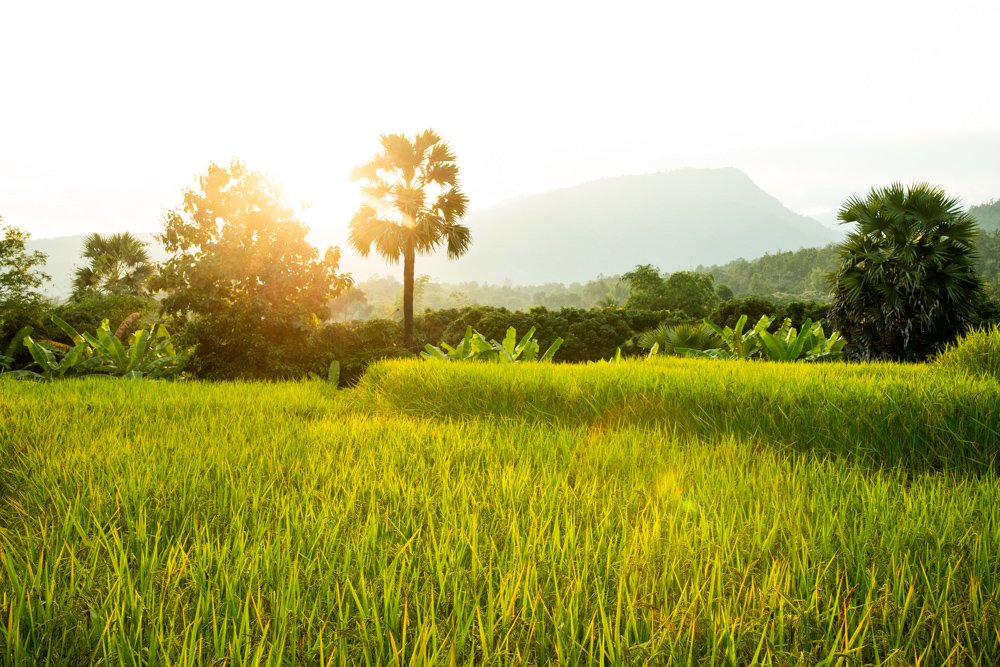
Northern Thailand’s Seasons: A Quick Look
Northern Thailand weather has three main seasons. Each one feels different and special. Knowing about them is the first step to planning a smart trip.
- Rainy Season (June – October): Many people don’t think about this season, but it makes Northern Thailand super green and lush. There are fewer crowds, and you’ll get warm, humid days with heavy, but usually short, rain showers. This is when waterfalls look amazing! (Discover why Mae Ya Waterfall is considered Doi Inthanon’s hidden gem.)
- Cool Season (November – February): This is the most popular time to visit. It’s usually sunny and dry with nice, warm days and cooler nights, especially in the mountains. This season is also known for big, fun festivals.
- Hot Season (March – May): This is the hottest time of year. It’s very dry, and there are fewer tourists. But watch out for the “burning season” (March-April). Farmers burn fields, which makes the air hazy and smoky. But this is also when the famous Song Khran Festival takes place.
Northern Thailand Month-by-Month: Your Detailed Plan
Now, let’s look at each month closely to help you plan your trip.
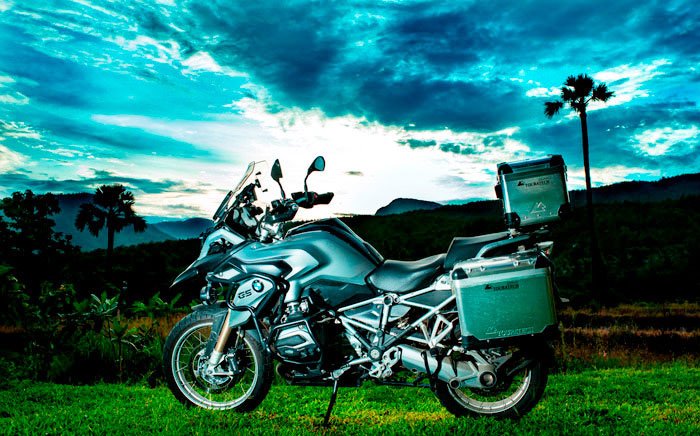
Cool Season Months: November – February
November
As the rainy season ends, November becomes a beautiful mix of rainy and cool weather. Days are comfy, usually around 20-30°C (68-86°F). Evenings get nicely cool, especially outside the main cities. The land is still bright green from the past rains, and the air is usually fresh and clear.
Good things: The weather is almost perfect for everything outdoors. A huge highlight is the Loy Krathong and Yi Peng festivals, in the middle of the month. Cities like Chiang Mai become magical with floating lanterns and sky lanterns.
Things to watch out for: It’s the start of the busy tourist season, so popular spots will start to get crowded, and prices for hotels and flights will go up.
Tips: Book your hotel and flights early, especially if you want to see the festivals. This is a very special time to experience Thai culture.
December
December is the heart of the cool season. It’s usually cool and dry with lots of sunshine. Daytime is around 15-28°C (59-82°F), which is great for exploring. Nights, especially in places like Doi Inthanon (Learn more about exploring Thailand’s highest peak from our homestay), Mae Salong, or Mae Hong Son in the mountains, can get quite cold, sometimes below 10°C (50°F).
Good things: The weather is perfect for hiking, seeing temples, and any outdoor activity. Skies are usually clear, which is great for photos. Christmas and New Year’s celebrations add to the fun.
Things to watch out for: This is the busiest time of year. Expect big crowds at all famous places, and hotel and flight prices will be at their highest.
Tips: You must book everything far in advance – hotels, popular tours, etc. Think about visiting smaller towns or less-known temples to avoid some of the crowds. Pack layers of clothes, especially if you’re going to higher places, as evenings can be chilly.
January
The weather in January is a lot like December: dry and clear. Days are still comfortable, though they might start to get a little warmer by the end of the month. The cool, crisp air stays, making it another great month for outdoor fun.
Good things: Still excellent weather for all kinds of outdoor activities, with clear skies for beautiful views.
Things to watch out for: Still very much the busy season, meaning lots of crowds and higher prices.
Tips: You’ll still need to book your travel and hotels ahead of time. Even with crowds, January is a great month to explore.
February
As February goes on, you’ll feel things getting warmer, meaning the hot season is coming. It’s mostly still dry, but the air can get smoky and hazy nearer the end of the month, especially in built up areas.
Good things: The weather is still nice for those who like it a bit warmer. You might find slightly fewer people than in December and January.
One of the things I love most about February is the Chiang Mai Flower Festival. This happens around the first week in February when the whole inner city is festooned with blooms. The Buak Hard Public park, located on the south west corner of the old city is worth a visit. There’s also a terrific parade with dazzling floats, dancers, bands, and more, typically on a Saturday morning in early February.
Tips: Do outdoor activities early in the morning or later in the afternoon to make the most of the cooler parts of the day.

Hot Season Months: March – May
March
March is usually the hottest and driest month in Northern Thailand. Temperatures often go above 35°C (95°F) and can even hit over 40°C (over 100°F). This is also the peak of the “burning season.” The air often gets very smoky and hazy, making it hard to see far.
Good things: This is the least busy tourist season, so you’ll find fewer crowds at places and cheaper prices for flights, hotels, and tours.
Things to watch out for: The intense heat can be very uncomfortable, making it hard to do outdoor things during the day. The poor air quality and haze can ruin views and might be bad for your health. The land looks dry and less green, and waterfalls often have low water levels.
Tips: March is generally not a good time if you have breathing problems or want to see green nature. Focus on indoor activities like cooking classes or massages. Stay in places with air conditioning during the hottest parts of the day. Drink lots and lots of water!
Come and stay with us here at Suan Sook Homestay. We’re nestled at the foot of Doi Inthanon, Thailand’s highest mountain. We often enjoy a cooling breeze flowing down the mountain valleys that clears the air.
April
April continues to be extremely hot, with similar temperatures to March. The burning season is also still at its worst this month, so expect more haze and smoke. Some years the rains arrive early, as they did this year. We’ve enjoyed good rains and some strong winds to clear the air since the beginning of April!
Good things: The best part of April is Songkran, the Thai New Year festival, usually in the middle of the month. It’s a huge water fight all over the country – super fun and refreshing in the heat! Outside of Songkran week, prices stay low and there aren’t many crowds. Learn more about the exciting Songkran (Thai New Year) festival. (Search for “Songkran” there closer to the event).
Things to watch out for: The extreme heat and bad air quality are still the main issues.
Tips: If you visit in April, definitely join in Songkran! It’s a unique cultural experience. Otherwise, prepare for the heat and haze like in March. Drink lots of water!

May
May is a change-over month. It’s still hot, but you’ll start to feel a shift as the rainy season begins, usually in the middle to end of the month. Some years the rains kick in for real during May, which clears the air and drops the temperatures. The first rains bring some welcome relief from the heat and start to clear the air, making the landscape transform into a lush, green extravaganza.
Good things: The land starts to become green, and the first rains help clear the air. It’s never cold when it rains. There’s not the dreariness associated with rainy days as there is in cooler climates. Prices are still low.
Things to watch out for: The weather can be unpredictable – you might have very hot, humid days followed by sudden, heavy rain.
Tips: May is good for travelers on a budget who want to see the land change. Be ready for sudden showers.
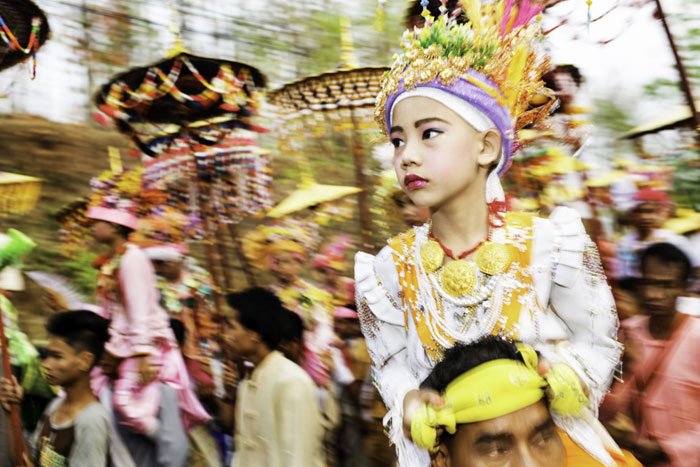
Rainy Season Months: June – October
June
As the rainy season really starts, June sees regular rain showers in the afternoon or evening. These are usually heavy but short, not lasting all day. Temperatures stay warm and humid, around 28-32°C (82-90°F), but feel cooler after the rain.
Good things: Northern Thailand turns into a lush, bright green paradise. Waterfalls get full, and rivers are flowing strong. You’ll find fewer crowds and lower prices for hotels and tours. Farmers are preparing their fields and planting rice, so the whole landscape is transformed into a tranquil, green vista.
Things to watch out for: Daily rain can stop your outdoor plans, and the high humidity can be uncomfortable. You’ll also notice more mosquitoes because of the wetness. This is not a problem if you cover up, use mosquito spray, and avoid being outdoors at dawn and dusk.
Tips: Pack a light raincoat or poncho )or pick one up at a 7/11 store) and waterproof shoes or sandals. Always carry a small umbrella. Use dry bags to protect your electronics, and bring mosquito repellent. Be flexible with your plans and have some indoor activities ready. Enjoy the rain – it makes the scenery beautiful!
July
July continues the rainy season, with steady rain, often in heavy bursts. It stays warm and humid, but the region truly comes alive with water.
Good things: Nature is at its most beautiful – the land is super green, and waterfalls are powerful. It’s a great time for photos. You’ll have a truly peaceful trip with very few tourists, and continue to find great deals. The rice continues to grow, carpeting the landscape in the most gorgeous lush, green hues imaginable, creating a vibrant, living tapestry across the valleys and hillsides.
Things to watch out for: The high chance of heavy rain means outdoor plans might change a lot, and hiking trails can get slippery and muddy.
Tips: Perfect for nature lovers and people who want a quiet, uncrowded trip. Make sure you have good waterproof gear.
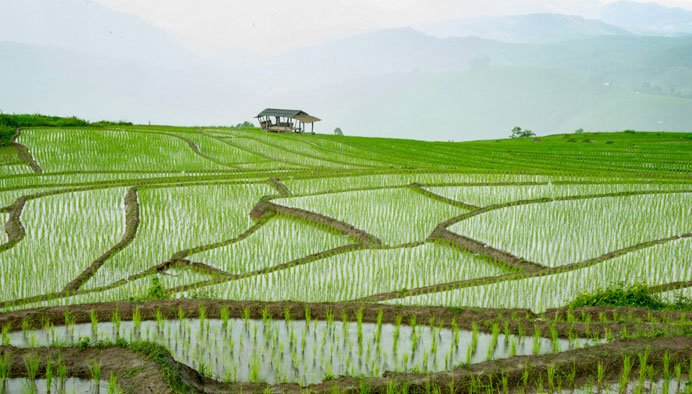
August
August is often the wettest month in Northern Thailand, with a lot of rain.
Good things: This is when waterfalls are at their most amazing, and the land is a deep, dark green. You’ll find the fewest tourists this month.
Things to watch out for: The highest chance of rain impacting your plans means you need to be ready to change things. Some smaller, unpaved roads might be hard to drive on with motorbikes or even blocked.
Tips: Best for those who really love the rainforest feel and don’t mind getting very wet. Always check local road conditions, especially if you plan to drive on smaller roads.
Our neighborhood is always delightful in August. Around Suan Sook Homestay the rice has matured and grown taller. There are large, expansive valleys and some terraced paddies, perfect for photography and an evening stroll.
September
As the rainy season slowly starts to end, September still gets a lot of rain, but it usually starts to lessen compared to August. It remains wet and humid.
Good things: The land is still beautifully green and full of life. You’ll find quieter places and excellent prices.
Things to watch out for: You can still have heavy rain, so be prepared.
Tips: This can be a good choice for travelers on a budget who want green scenery without the absolute most rain.
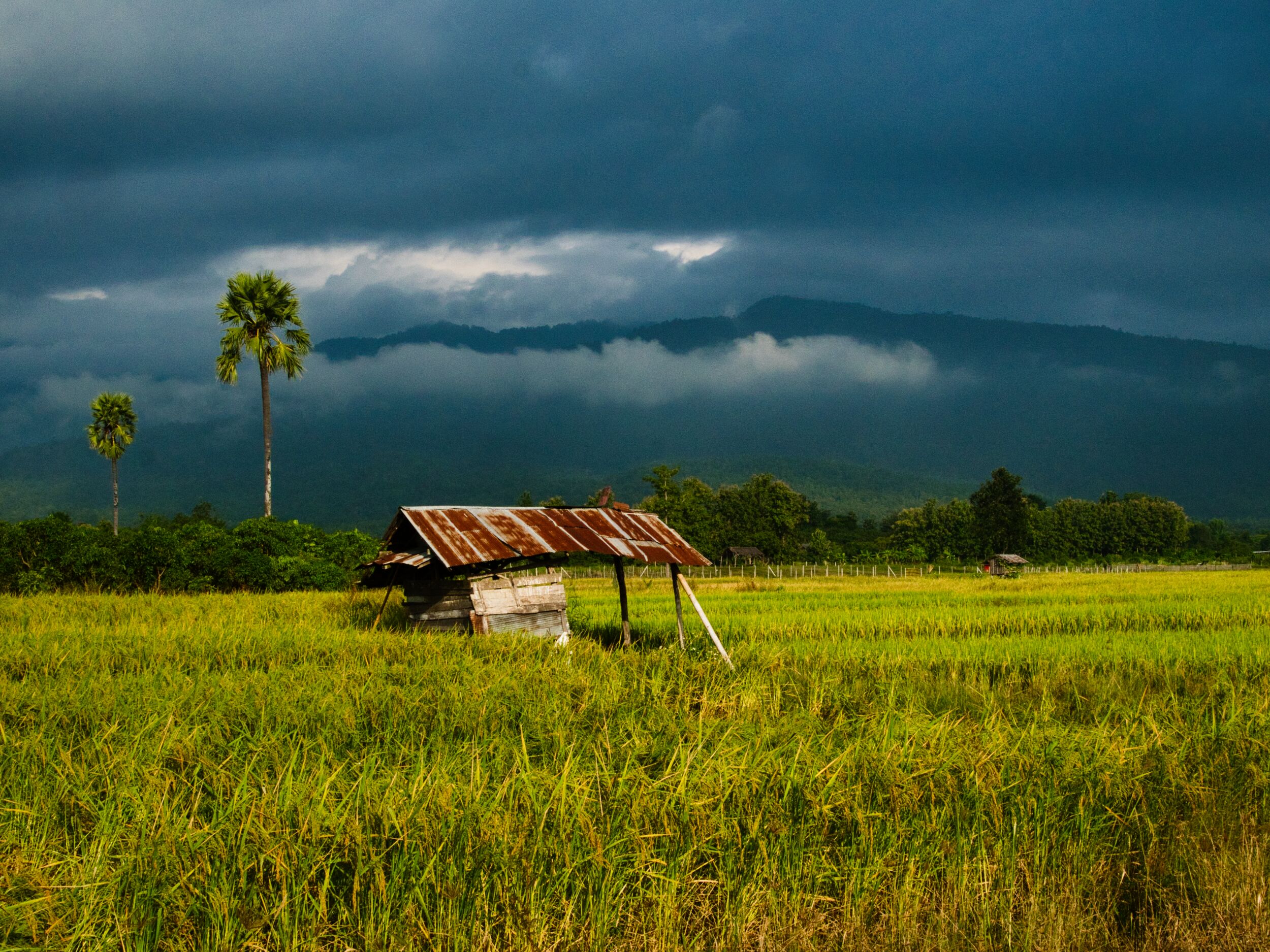
October
October is the last month of the rainy season. Rain continues to slowly stop, and the weather gets nicer, less humid. Temperatures are warm but comfortable.
Good things: The land is still very green and bright, but the weather is clearly getting better. There are fewer crowds than in the cool season, making it a great value month to visit.
Things to watch out for: You can still get some rain, especially earlier in the month, but long, heavy downpours are less common.
Tips: October is often an underappreciated month to visit Northern Thailand. It offers a good mix of green nature and improving weather before the main tourist rush starts again.
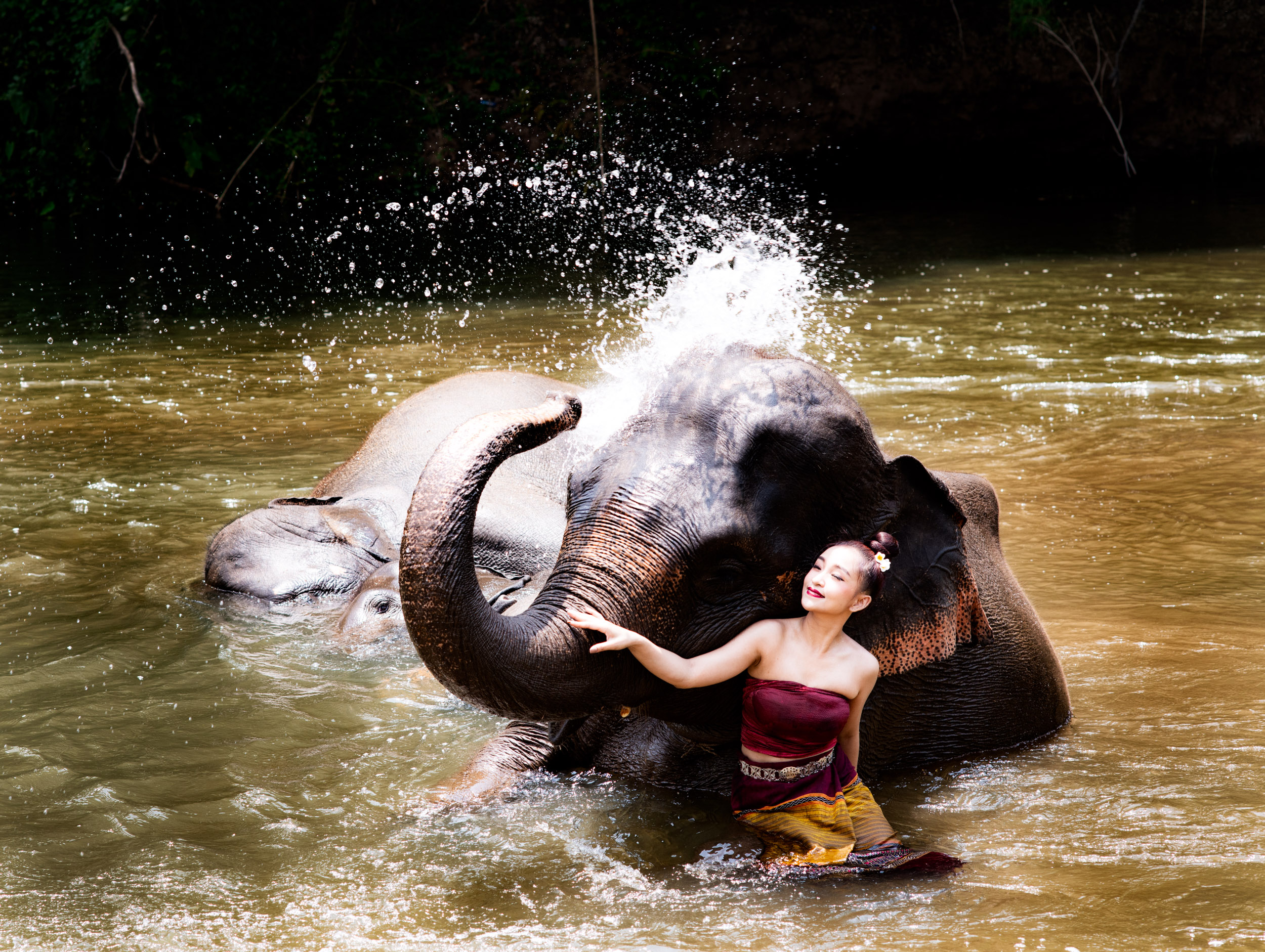
What to Pack: Essential Tips for Northern Thailand Weather
No matter when you visit, it’s smart to pack certain things. Here are some general tips, plus what you might need to help you enjoy northern Thailand weather for each season:
- General (All Year): Light, breathable clothes (cotton and linen are great), comfy walking shoes or sandals, sunscreen, a hat, sunglasses, and bug spray.
- Cool Season: Bring a light jacket, sweater, or warm top for cooler evenings, especially if you go to the mountains where it gets quite cold.
- Hot Season: Focus even more on drinking lots of water. Pack very light and loose clothes to stay cool.
- Rainy Season: A light rain jacket or poncho is a must. Use waterproof bags or dry bags inside your backpack to keep your electronics safe. Shoes that dry quickly, like sturdy sandals or water shoes, will be very helpful. A small umbrella is also good for sudden rain or even for sun.
Your Perfect Northern Thailand Trip Awaits!
So, from the refreshing rains to the comfy cool and the lively heat, Northern Thailand weather truly offers something special all year. We hope this month-by-month guide helps you decide when to pack your bags and what to expect. For a quick video guide to these seasons and tips, make sure to watch our video about northern Thailand weather.